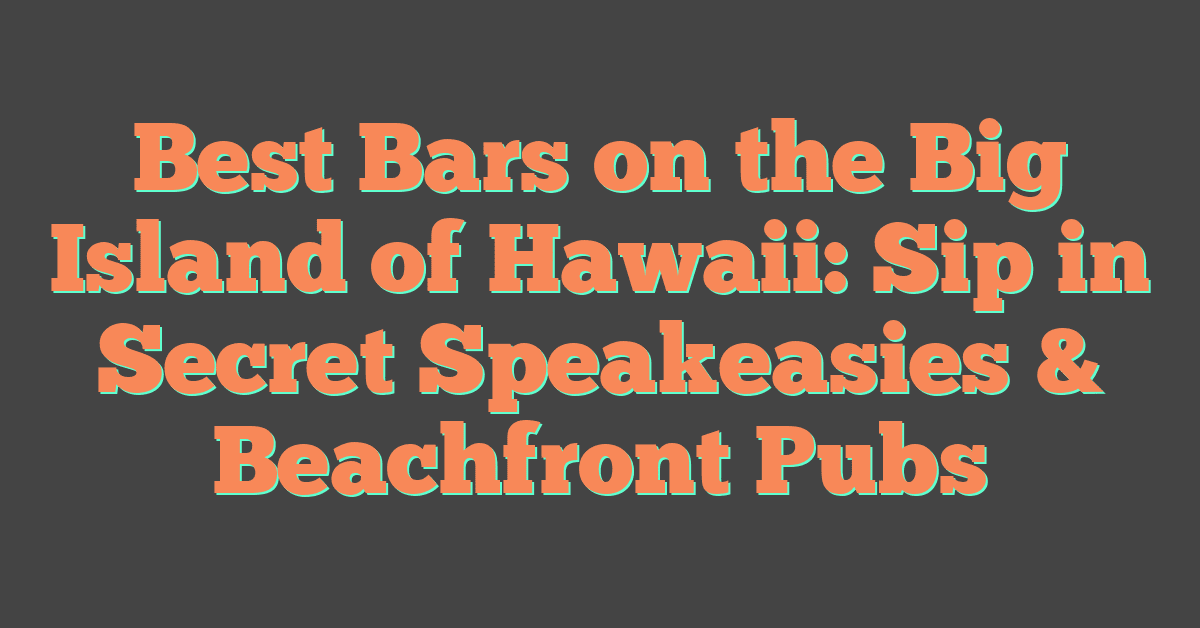When I think about Hawaii, I picture clear waters and fresh seafood. But there’s more happening under the surface—Hawaii’s fishing industry is working hard to protect the ocean and keep seafood supplies steady for future generations.

Hawaii’s fishing industry is going green by using sustainable fishing methods, setting conservation zones, and focusing on protecting local marine life.

These changes help keep Hawaii’s unique ocean ecosystems healthy. For example, local fishermen follow strict rules like daily reporting and exclusionary zones to avoid overfishing and protect certain areas.
Knowing where my seafood comes from and how it’s caught makes every meal feel more meaningful.
Overview of Hawaii’s Fishing Industry
Hawaii has a unique fishing industry built on fresh, high-quality seafood and traditional methods. I see how it shapes the island’s culture, economy, and daily meals, through commercial fishing, important species like tuna and swordfish, and busy local seafood markets.
Commercial Fishing and Seafood Production
Commercial fishing is a major business in Hawaii. Most of the seafood comes from the Hawaii longline fishery, which uses boats with long fishing lines to catch tuna, swordfish, and more off the coast.
In Honolulu, workers carefully ice and deliver the catch fresh every day. The seafood brings in high value, even though the total weight is less than in big mainland ports.
For example, Honolulu ranked 8th in landed value in the country, with more than $59 million from about 22.3 million pounds of fish in a year. You can read more about these stats from Hawaii’s seafood industry.
Many fishing families have passed down their knowledge for years. They use every part of the fish, which reduces waste and respects the value of each catch.
Key Species: Tuna, Swordfish, and More
Tuna and swordfish lead Hawaii’s seafood scene. I find the most caught tuna species are bigeye tuna and yellowfin tuna.
Swordfish is also a major target, especially for export and fine dining. Other local favorites include mahi-mahi, ono, and opah.
While tuna and swordfish bring in the most money, these other fish are important for restaurants and families. The Hawaii longline fishery targets these key species with strict rules to keep stocks healthy and avoid harming rare animals.
Here’s a table showing key species and their roles:
| Fish | Importance | Method Caught |
|---|---|---|
| Bigeye Tuna | Export, local sales | Longline |
| Swordfish | Export, restaurants | Longline |
| Mahi-mahi | Local consumption | Various methods |
| Opah | Restaurants | Longline |
Local Seafood Markets and Consumption
Local seafood markets in Hawaii are lively and central to daily life. The best-known is the Honolulu Fish Auction, where early each morning, sellers offer fresh catches directly to buyers, shops, and restaurants.
Most seafood eaten in Hawaii is caught right here. Favorite dishes in homes and restaurants highlight fresh local fish, such as poke made with tuna and grilled swordfish steaks.
Demand stays steady, with families and tourists all wanting the taste of local species. New efforts encourage buying local seafood, which helps fishermen and keeps money in the islands.
Hawaii’s focus on “fresh, local, and sustainable” is strong in both markets and daily seafood consumption.
Traditional Practices and Fishery Management
In Hawaii, people make ocean care part of everyday life. I see how ancient Hawaiian methods and modern rules work together to help keep fish populations healthy and support local communities.
Fishponds and Community Stewardship
Hawaiian fishponds, or loko iʻa, are ancient forms of aquaculture that people still value today. These ponds use rock walls to trap fish, letting small ones enter while keeping larger fish inside for harvesting.
Local families care for these fishponds together. They do regular maintenance, check water quality, and look after the surrounding plants and animals.
Traditional knowledge guides activities so that fishponds stay productive without harming the local environment. This way of managing the land and water is called the ahupuaʻa system, which connects mountains to the sea.
Today, communities and projects restore old fishponds, bringing back techniques that support both food security and cultural practices. For more on the importance of Hawaiian fishponds, I find NOAA’s article about fishponds helpful.
Fisheries Management and Regulations
Fishery managers in Hawaii blend traditional wisdom with modern tools. Many fishing rules and practices draw inspiration from old ways, such as only harvesting what’s needed and respecting closed seasons or areas.
Community members monitor resources and share their knowledge with scientists. This partnership uses the Hawaiian moon calendar to guide responsible fishing, giving fish populations time to recover.
Key organizations, like the Western Pacific Regional Fishery Management Council, create rules with input from both local communities and experts. By adapting harvest practices to local conditions and following clear management plans, Hawaii protects both ocean resources and cultural values.
For an example of traditional knowledge used in regulation, I recommend reading about community-based approaches at this fisheries management PDF.
Advancements in Sustainable Fishing
Hawaii’s fishing industry keeps going green through ongoing work and new ideas. People maintain healthy ocean resources, use smarter technology, and follow strict rules.
Sustainable Development Initiatives
I see that sustainable development is key for Hawaii’s fishing industry. Local fisheries, like the Hawaii longline fishery, follow strong science-based rules set by national and international groups.
These rules help control fish populations and prevent overfishing. Efforts include regular checks of fish stocks, size limits, and seasonal closures.
These actions protect the environment and help fish populations recover. Hawaii’s fisheries also aim to reduce their impact on the ecosystem.
For example, people choose fishing methods that avoid catching unwanted species like turtles and seabirds. Organizations and government agencies work together to monitor and enforce these practices.
Public education and community involvement play a big part in sustainable fishing in Hawaii. By keeping everyone informed, Hawaii makes sure natural resources stay protected for the future.
Technological Innovations and Best Practices
Technology is making fishing more responsible. GPS tracking lets captains avoid protected areas, while satellite data helps them find healthier fish stocks.
Bycatch reduction devices, such as circle hooks and turtle excluder devices, keep animals like sea turtles and dolphins safer. These tools make fishing methods more selective and less harmful to ocean life.
Eco-labeling programs encourage best practices. Certified fisheries, such as the longline fleet, must meet high standards for sustainability.
This shows buyers and consumers that the seafood supports responsible management. Better storage and handling mean more fish survive after being caught, reducing waste.
These steps, along with strong oversight, help me feel confident about Hawaii’s efforts to care for the environment and local communities.
Role of Aquaculture in Hawaii’s Green Future
Aquaculture offers a clean way for Hawaii to boost local food production and support the economy without harming the environment. It gives us new tools for farming fish, shellfish, and seaweed while protecting ocean life.
Growth of the Aquaculture Industry
I’ve noticed Hawaii’s aquaculture industry has grown quickly in recent years. In 2023, sales from aquaculture reached $90 million, and experts predict fast growth in the next five years.
This growth comes from demand for local seafood and new investments in technology. The industry’s main goals include expanding algae production, which could top $391 million by 2030, and creating new value-added products from fish and shellfish.
Local organizations, businesses, and lawmakers work together to help the sector grow responsibly. Some key benefits of expanding aquaculture are reducing the need for imported seafood, creating jobs, and supporting sustainable practices.
For more details about how the sector is set to expand, see this report on Hawaii’s growing aquaculture industry.
Finfish and Shellfish Farming
Finfish and shellfish farming are at the heart of Hawaii’s aquaculture development. Fish like mullet and moi are raised in pens offshore, letting people enjoy fresh seafood raised locally and sustainably.
Shellfish such as oysters are also farmed, providing both a renewable food source and helping filter the water. Seaweed farming is another important part of the sector.
Seaweed grows quickly, absorbs nutrients, and supports healthy reef ecosystems. These methods put less pressure on wild stocks, help restore natural habitats, and use fewer resources than wild fishing.
To learn more about how Hawaii raises both finfish and shellfish through aquaculture, visit this resource on offshore aquaculture and species farmed locally.
Addressing Overfishing and Fish Populations

Hawaii’s fishing industry faces challenges with overfishing and changes to native fish populations. Managing these problems takes both strict conservation and new ideas to restore balance in the ocean.
Balancing Commercial Demand with Conservation
Overfishing threatens many of Hawaii’s favorite reef fish, like kala and several grouper species.
Recent studies show that fishers catch at least 11 local reef fish faster than the fish can reproduce.
Fish stocks face risk, and the fishing industry may suffer if nothing changes.
State agencies now limit the catch of certain species to help balance commercial demand and protect ocean life.
They collect data and work with local fishers to set size limits, closed seasons, and gear restrictions.
Agencies also create marine managed areas to give fish time and space to rebuild populations.
Hawaii combines traditional and Western science to protect reefs.
By mixing local knowledge with new research, communities find creative solutions to keep fishing sustainable.
For more on this, read about Hawaii’s efforts to track coral reef fish health.
Invasive Species and Restoration Efforts
Invasive species also threaten native fish and can change the entire ecosystem.
For example, invasive algae and some sea urchins take over reefs when natural herbivores decrease.
Teams now remove invasive species and use restored native urchins to eat problem algae.
These restoration efforts give the reef a better chance to recover and help fish populations grow.
Managers use the concept of maximum sustainable yield to decide how much fish people can safely catch.
Local programs restore coral and seagrass, which give young fish shelter.
For more details, check out Hawaii’s coral reef crisis and new restoration strategies.
Environmental and Economic Impacts

Hawaii’s fishing industry is making many changes to lower its environmental impact.
New efforts address both climate change and the flow of seafood products in and out of the state.
Climate Change Adaptation
Climate change already affects Hawaii’s oceans.
Warming seas stress fish populations and change where certain species live.
Hawaiian fishers work with scientists to study fish stocks and adjust practices.
Some fishers use new gear or change fishing areas to target more abundant species.
Many rules now protect the marine ecosystem, such as closing certain zones to fishing during spawning times.
Managers set catch levels and rules on bycatch to keep fish populations stable.
Seafood Trade and Sustainability
Hawaii imports large amounts of seafood.
To support local fishers and reduce imports, people can choose local, sustainably-caught fish when possible.
The industry follows strict rules that prevent overfishing and minimize harm to protected species.
For example, fishers work with scientists and managers, using circle hooks and special gear to avoid catching turtles or seabirds.
On Hawaii Seafood’s sustainability page, communities track fish stocks and follow science-based advice to keep populations healthy.
Eating local fish also cuts the carbon footprint from long-distance shipping.
Sustainability measures protect both the ocean and the economy.
Reducing the Seafood Trade Deficit
Hawaii imports more seafood than it exports. This situation creates economic challenges for local fishers.
We can address this by increasing local production through sustainable methods. Supporting local fisheries keeps more money in Hawaii’s economy and creates jobs.
Promoting underused species and improving seafood processing also help. Local campaigns encourage restaurants and families to buy Hawaii-caught fish.
A study on fisheries’ economic impact shows that strengthening local supply chains reduces the deficit. This approach supports a greener industry and benefits communities.




